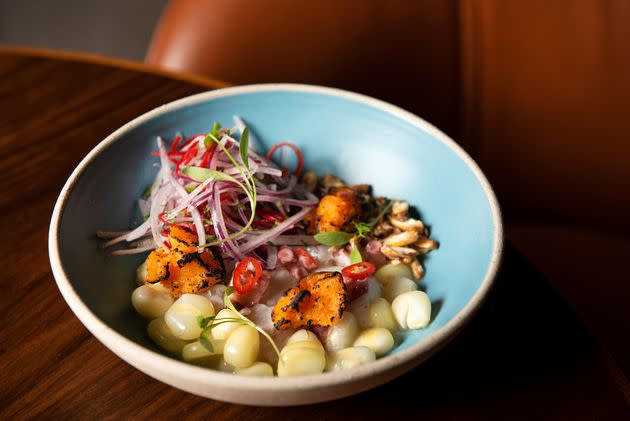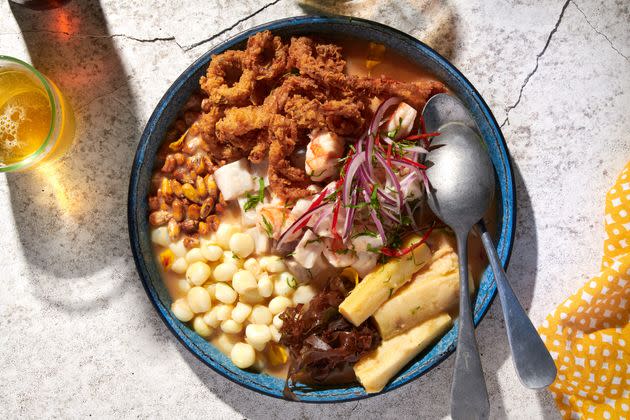Making Ceviche At Home? Avoid These 5 Common Mistakes

Fresh, bright, acidic and spicy, ceviche is a Peruvian dish that’s perfect for summer. It consists of raw fish marinated in an acid, like lemon or lime juice, plus aromatic ingredients like chili peppers, onions and cilantro. While the texture of ceviche may feel like eating raw fish, the acid “cooks” the fish by denaturing its proteins. The longer it marinates, the more opaque and firm the fish will be. (It’ll never be the flaky texture of traditional cooked fish, though.)
The dish is easy to prepare, but there are food safety risks you should be aware of if you decide to make it at home. We spoke with experts to learn the do’s and don’ts of making ceviche in your own kitchen, covering everything from bacteria to the art of squeezing fresh limes. Here are some of the most common mistakes people make, and how to avoid them.
Mistake #1: Giving yourself food poisoning
Since the main ingredient in ceviche is raw fish, it’s important to take precautions to keep yourself safe.
First, the fish. This isn’t a time to skimp on quality and freshness. “Look for sushi-grade fish that is fresh, and it’s even better if it’s local,” Frank Proto, director of culinary operations at the Institute of Culinary Education in New York City, told HuffPost. “Never pick freshwater fish, as they can carry parasites, and instead opt for cold-water, fresh fish from the ocean. Avoid certain species like cod, monkfish and swordfish that are highly parasitic.”
When it’s time to cut the raw fish, Proto recommends wearing gloves. “You should wear gloves when prepping food items that aren’t being cooked because your hands have bacteria on them and you aren’t heating the food to 165 degrees Fahrenheit or above, which sanitizes food,” he said.
It’s also a good idea to wash and sanitize your chopping board after you cut raw fish on it. Because of this, Proto prefers to slice and chop his other ingredients (like vegetables, lemon and lime) before he cuts the fish, so he only needs to clean the cutting board and knife once. “If you cut the fish first, make sure to properly clean the knife and board before cutting anything else,” he said.
Lastly, keep the raw fish cold. This means keeping it in the refrigerator until you’re ready to slice it, and putting it back in the fridge when it’s marinating. When making ceviche, Proto puts the fish in a bowl that sits in another bowl filled with ice. This way, the fish stays cold without getting waterlogged.
Mistake #2: Squeezing your citrus too hard
Acid is a crucial ingredient in ceviche, and while it may be tempting to try and squeeze every last bit out of your lemons or limes, that approach may result in a bitter flavor. Alexander Diestra, executive chef of Andina and Chicha in Portland, Oregon, told HuffPost that the best way to get the flavor and juice out of a lime is to give it one good squeeze and call it good.
Diego Muñoz, chef de cuisine at Popular, a Peruvian restaurant at Public Hotel in New York, explained that if you squeeze citrus fruits too hard, the pith will release essential oils that can be bitter. How hard you squeeze lemons or limes can be the difference between a delicious ceviche and a bitter one. To help resist the temptation of over-squeezing, it’s best to start with fresh, juicy lemons or limes.
Mistake #3: Marinating for longer than 20 minutes
As mentioned before, the longer the raw fish sits in the marinade, the more it “cooks,” resulting in a more opaque color and firmer texture. How long you choose to marinate your ceviche will depend on your personal preference in terms of flavor and texture.
Marinating times varied slightly among the chefs interviewed for this story: Diestra recommends that the fish sit no longer than five minutes before serving, while Proto recommends a 15- to 20-minute marinating period in the refrigerator to let the flavors meld. Muñoz simply gives the fish a few quick stirs to coat it with the marinade and serves it pretty much raw.

Diestra explained that allowing the fish to marinate for too long in the acid will result in a tough texture. Therefore, when making ceviche, it’s good practice to only make as much as you’re planning to serve or eat at that meal.
“Don’t make enough for leftovers,” Proto said. “The taste and texture of leftovers will be different, partly because the acid will continue to denature the proteins in the fish, resulting in a firmer texture.”
Mistake #4: Slicing the fish with the grain
When cutting into the beautiful fish you’re using for making ceviche, being deliberate and precise is the key to getting nice cubes of fish that are easy to eat. “Some people like their fish in cubes, and some people like it in slightly thinner slices,” Muñoz said.
Muñoz stresses the importance of properly slicing the fish. “You need to understand that you’re going to have a straight bite of what’s pretty much uncooked protein, so you need to try to go against the grain of the muscles so that you get a gentle bite,” he said.
Mistake #5: Not tasting the marinade
To achieve the perfect balance of flavors, it’s important to taste your marinade, particularly if you’re new to making ceviche and still figuring out the best ratios of ingredients.
“When you’re building the marinade, make sure you can still taste the fish,” Proto said. “Mix together the marinade ingredients and taste it before adding the fish, to make sure the flavors are balanced and that you like it. Once you add the fish, wait about five minutes, then re-taste to make sure the seasoning is right.”
Proto’s go-to basic ceviche recipe incorporates lemon, lime and orange juices (the orange juice adds sweetness), sliced red onion, jalapeños, chopped cilantro, a little ketchup (for sweetness and to bind the marinade together), salt, pepper and your choice of fish. Proto’s selections include fluke, red snapper and scallops.
With a simple dish like ceviche, using fresh ingredients in the proper proportions is key, as there’s nowhere to hide. “It’s a super-simple dish, but it’s easy to mess it up, as well,” Muñoz said. “What we’re looking for is a harmonious balance between acidity, saltiness, umami and spicy, where no one flavor overtakes the others.”
This article originally appeared on HuffPost and has been updated.

 Yahoo News
Yahoo News 


